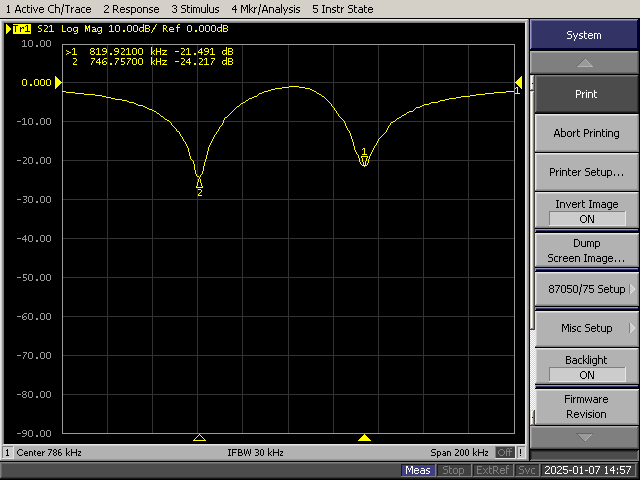
Medium Wave Rejection Notches
I had a perceived problem with our Local Kiwisdr remote receiving site
,I noticed the formation of intermodulation products sometimes in the 26 to 30
Mhz section ( and lower down as well ) I suspect intermod as when I
listened to them close in I could hear a coupleof radio stations mixed up .I was
not sure if its the low noise rf amp 22 db with 12 db attenuation on the
out put or the action of 2 very stron HF Medium wave
frequencies at received levels of -37 and -38 Dbm 747
Khz and 819 Khz , most other signal strengths tended around
-50 dBm or below ,so for starters I will try to minimise the problem .
I forst thought of a performance high pass filter whicj I build after
consulting with the very good "student " filter design program "ELSIE"
It worked well in the VNA but then I thought there goes all reception from
17-- KHz and below so I opted in trying to reduce the unwanted
signals . The easiest way to do this is to put series resonant circuits at the
unwanted frequencies "short circuiting" the earth and centre of the
antenna coax .
This is easy to achieve but I found some caveats . If you
want to have a narrow bandwith and good depth of the rejection notch then you
have to use High Q quality components , this I found out the hard
way . I looked at rejection notch circuits for medium wave bands and they
consisted of low inductance 4-20uH with series capacitance values in the
1000's range so be ware , some ferrites unknown were "flat" so
obviously had low "Q" at these frequencies I had a good range of philps
torroids and the best one I found was a light purple that almost had a fuzzy
look to it o.d. about 18mm . the inductance value used was around the 30
Turns region and tried some random capacitors 2n2
3n3 ceramic capacitors aand that bought up broadcast band frequencies but
the VNA sweep showed shallow wide responses ( low Q) so I
tried some polyester capacitors and strarted to get much better responses
narroer and deeper notch , dipped mica caps were good but I only had them
up to 200 pf but the polys were up to 1000 pf ,so I swent with them
the only problem was the small range of polys I had and torroids jump in
increments when you add and remove turns ( I did try the old trick of
incorperating a tuning slug in thetorroid windings but the inductance change was
so small .(.see photo ).I did managed to get a good close combination with
poly cap additions and turns , and mananged to use some Philips "behive"
trimmers to actually tune the response to what I wanted .
.The behives are really old school but they are stable , airspaced hence
high "Q" so were pressed into service , I ended up with around 510Pf
polys and behive trimmer and 27 Pf in parallel with about 30 odd turns on
the torroid +/- turns to tune ..

